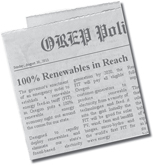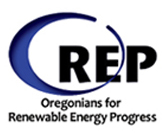Sustainable Local Food: Sustainable Local Energy
In recent years, much has been said about the benefits of local food production. We have learned to consider our food choices, not just based on taste and convenience, but thinking of all the steps that went into its production and arrival on our table. Applying the same way of thinking to our energy diet reveals many parallels between where and how we produce our food and where and how we produce our energy.
We see our food choices as a way to improve both our own health and also the health of the planet. We have begun to understand that if a vegetable is grown at a local farm, it takes less energy and packaging to get it to our plate. We’ve begun to ask questions about our food supply:
Was this food produced with as little impact on my environment as possible? Did it travel from a distant location or was it harvested nearby? Was its production economically beneficial to my local community or did I send my food dollars out of my state, my region, or my country?
All this has brought a much needed sustainable approach to our grocery shopping. But what parallels can we draw between food and energy? Both food and energy power our lives. Both can be produced near where we live. Both will continue to be consumed for the rest of our lives. Both are profit centers that can support those who control their production, sale, and distribution.
Over the last 100 years, electricity consumption in our country has grown steadily. Our access to fossil fuels is diminishing, and extraction of the remaining reserves takes an ever more extreme toll on our fragile land, water, and air. We understand now that our energy habits of the past are not sustainable. As we consider our options for a new energy future, we should question:
Will this energy be produced with as little impact on my environment as possible? Will it travel from a distant location or will it be harvested nearby? Will its production be economically beneficial to my local community or will I send my energy dollars out of my state, my region, or my country?
Sound familiar?
Now is the time to build a movement for locally-produced sustainable energy in parallel with the thriving Local Sustainable Food movement. Why pollute the environment when there are sustainable options available? Instead of buying and shipping fuel across the globe, we can tap the abundant renewable resources right in our own backyard. Rather than send our hard earned energy dollars out of state, we can buy clean, local energy from local farmers and our neighbors.
Let's look at three parallel issues that pertain to local sustainable food and local sustainable energy alike:
Direct Impact on our Environment
Factory farms and the intensive use of pesticides and herbicides by agribusiness destroy the soil, pollute the water and air, and introduce persistent chemicals into the food chain. Local family farms work with nature to support healthy soils, plants, and animals with minimal use of dangerous chemicals, antibiotics, hormones, and fossil fuels.
Large, centralized coal, diesel, and natural gas power plants generate electricity from fossil fuels that pollute our groundwater, soil, and air. The continuous extraction of coal and gas to feed these power plants continuously damages local ecosystems, and the burning of fossil fuels persistently introduces greenhouse gases and toxic chemicals such as mercury and dioxins into the environment. Local, decentralized renewable energy systems, such as solar and wind, work directly with the cycles of nature, reducing surface and air pollution. While some resource extraction is required to build clean energy infrastructure, clean energy’s fuel sources (water, wind, and sunlight) are free, non-polluting and require no ongoing extraction.
Transportation and Distribution
Local food production means lower transportation, packaging, and distribution costs, both in dollars and in energy spent moving and refrigerating the goods.
Locally produced energy proves to be more efficient because the energy is generated near where it is consumed, and less energy is lost across long transmission lines. And the more clean energy we can produce in population centers, the fewer new transmission lines will need to be sited and built to transport energy long distances. The U.S. Department of Energy’s National Renewable Energy Laboratories (NREL) estimates that Oregon rooftops alone could generate 7,000 MW of electricity from solar PV. As an added bonus, energy reliability of intermittent renewable resources such as solar and wind is enormously improved by drawing power from a large number of small or medium-sized generators distributed over a region. Compared to the large, centralized model, a distributed renewable energy network experiences fewer power "surges" or power "dead zones" due to regional weather conditions, such as strong winds or loss of solar exposure from cloud cover.
Local Economic and Social Benefits
When we purchase food from a local farmer, more of our food dollars stay in the community. That farmer pays local suppliers; they pay their local employees; those employees spend their paychecks locally, multiplying the effect of our food dollars in the local economy. When we purchase food from a factory farm, more of the profits are likely to go to out-of-state corporations and their investors.
Likewise, when energy is produced and sold by corporate investors and large commercial developers, we ship our energy dollars out of the state. Governor Kitzhaber estimates that 85% of Oregon’s energy dollars now leave the state. That is more money than we spend on K-12, community college, and higher education combined! When local farmers, small businesses, citizens and communities can easily own and invest in local energy systems by producing, selling, and purchasing electricity from clean local sources, the economic benefits remain within our local region. Moreover, as we develop Oregon’s abundant renewable resources, many local jobs will be created around the direct and indirect needs of this new local clean energy infrastructure.
We've also seen the social benefits that can come from community gardens and local farmers' markets as friends and neighbors gather together. As communities come together to "grow" their own clean energy “gardens” or support community owned projects at local schools, community centers, or places of worship, these same benefits will follow the path of our energy choices.
So what next?
We are at a watershed moment of opportunity in our history. If we create a new energy infrastructure that is based on the old, centralized, corporate model, energy dollars will continue to leave our communities. Citizens will have no choice but to purchase power from large corporations through energy policies that favor corporate interests.
Alternatively, sustainable local energy need not be a dream of the future. A renewable energy feed-in tariff has proven the most successful policy to rapidly spur the development of sustainable local energy and put power production in the hands of citizens, because it enables utility customers to produce and sell clean energy to their utility profitably. So far, Germany’s feed-in tariff program has created 17,000MW of solar energy, of which 60% is owned by farmers and citizens.
In the coming year, Oregonians will have the opportunity to shape our state’s energy future by actively engaging in Governor Kitzhaber’s developing Ten Year Energy Plan. The Task Force will begin accepting written comments on the Energy Plan in late March. Around the end of April, the Task Force will begin touring the state to gather your input through a series of public meetings. Stay tuned to OREP’s website for details about times and locations as they are announced.
Oregon’s Ten Year Energy Plan is our opportunity to demand sustainable, local energy in Oregon that supports citizens and communities throughout our state. We can create a smarter, more equitable energy system, but only if we demand fair energy opportunity through a policy with the average citizen first in mind.
Jon Roschke, OREP


